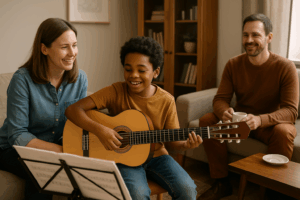As private music teachers who work closely with beginner students, we’ve seen how small adjustments can make a big difference in a student’s musical journey. One key insight? The biggest mistake in music lessons often isn’t about wrong notes or missed practice sessions—it’s about forgetting who should be steering the ship. When teachers or parents set all the goals, we risk losing student engagement. But when students take the lead, everything changes.
Why Letting Students Set Goals Works
We’ve all been there—setting up structured lessons, selecting repertoire, planning performance timelines—only to discover our student seems… uninterested. The truth is, when teachers set all the goals, students may not feel connected to their own progress.
Instead, when we encourage students to:
- Choose songs they enjoy
- Set short-term practice targets
- Reflect on their own musical growth
…they become more invested in the learning process.
This approach creates autonomy and makes music lessons feel rewarding. It’s a simple shift, but it’s one that transforms a routine class into something meaningful.
What Happens When Teachers Set All the Goals
When adults dominate the goal-setting process:
- Students lose motivation because they’re playing music they don’t connect with.
- Progress slows down as lessons feel more like chores than choices.
- Practice habits fade because students aren’t emotionally tied to what they’re learning.
In short, this is the most common mistake in music lessons—prioritizing structure over student interest.
How to Fix It: Student-Led Lesson Planning
Here’s what we recommend for avoiding this pitfall:
1. Start each semester with a student interview.
Ask what they want to learn. Let them tell you their goals—even if it’s “learn Star Wars.”
2. Offer choices.
Instead of assigning one piece, let students choose from three that target the same skill.
3. Reflect together.
At the end of each month, talk about what worked and what they’re proud of.
This collaborative approach is especially effective with beginner students, who thrive when they feel heard and empowered. To support this method, our guide on setting realistic goals in music lessons offers helpful tips for keeping students motivated and moving forward.
Real-Life Example
One of our beginner guitar students came into lessons wanting to “just learn Taylor Swift.” Instead of redirecting him to classical studies, we leaned in. By focusing on chord progressions from songs he loved, he built technique and theory skills faster than students with more rigid assignments. And yes—he’s still taking lessons two years later.
FAQ
Why do students lose interest in music lessons?
Students often lose interest when they don’t feel ownership over what they’re learning. Giving them choices keeps them engaged.
Can beginner students really set their own goals?
Yes! Even simple goals like “play this song for my cousin” give students a reason to keep practicing and improve.
Is structure still important?
Absolutely. Structure matters—but when it’s built around a student’s personal interests, it becomes much more effective.
Final Thoughts
The biggest mistake in music lessons is forgetting that the student’s voice matters. By encouraging student-led goal setting, we help our students stay motivated, make steady progress, and develop a lifelong love of music.
For more ideas on how to support your child’s musical journey, check out this research-based article from PBS on the broader benefits of music education.
